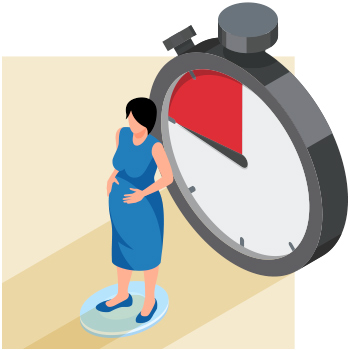
We’re all familiar with the concept of a pregnant woman’s “water breaking” as she goes into labor. In movies and television, this well-known moment is often humorously embarrassing, as the expectant mother notices her water breaking at the most inopportune of times or in the worst of places.
But in real life, the breaking of a woman’s water—and more specifically, the timing of it—is very serious. If that water breaking occurs too early or lasts too long, it can pose dangerous risks to mother and baby, including infection, which can lead to cerebral palsy and other complications.
What is Rupture of Membranes?
When a woman is pregnant, a fluid-filled bag called the amniotic sac surrounds and protects the fetus. Rupture of membranes (ROM) is a medical term for what’s commonly referred to as “water breaking” and is a normal part of pregnancy. When a woman’s “water breaks,” the amniotic sac surrounding the fetus breaks, releasing amniotic fluid. A woman’s water typically breaks during the early stages of labor.
When a woman’s membranes break by themselves, we call this spontaneous rupture of the membranes. Spontaneous rupture of membranes most often happens after active labor has started. If needed, the membranes may be ruptured artificially by the doctor or midwife to start or speed up labor.
What is Prelabor or Prolonged Rupture of Membranes?
Prelabor rupture of membranes occurs before the onset of regular uterine contractions. Prolonged rupture of membranes is any rupture of membranes persisting for greater than 18 hours. Prolonged rupture of membranes can lead to infection and birth complications for the baby.
What Causes Premature Rupture of Membranes?
Premature rupture of membranes (PROM) occurs before the onset of regular uterine contractions AND when the pregnancy is less than 37 weeks gestation. Before term, PROM is often due to a vaginal or uterine infection. Other factors that may be linked to PROM include:
- Sexually transmitted infections, such as chlamydia and gonorrhea
- Previous preterm birth
- Vaginal bleeding
- Cigarette smoking during pregnancy
- Precious cervical surgery, including biopsies
- Shortening of the cervix requiring a cerclage
- Previous overstretching of the uterus or overstretching of the amniotic sac from a multiple gestation pregnancy
- Poor nutrition
- Other unknown causes
What Risks and Injuries are Associated with Prolonged Rupture of Membranes?
When the amniotic sac protecting the baby breaks too early, the baby becomes at risk for early onset infection. Intrauterine infections of the placenta or fetal membranes can increase the risk of cerebral palsy in the baby.
Additional complications from prolonged rupture of membranes include:
- Prolapsed umbilical cord: A “prolapsed cord” occurs when the umbilical cord exits the cervical opening before the baby. Oxygen flow can be cut off or diminished when the umbilical cord becomes compressed between the baby and the structures of the uterus. Although rare, a “prolapsed cord” is an obstetric emergency.
- Premature birth: If active labor begins after the membranes rupture, premature delivery often occurs. A woman who is 34 weeks gestation with rupture membranes should have labor induced following the administration of steroids for fetal lung maturity. If the mom or baby is unstable, steroid administration should not delay delivery.
- Hypoxic ischemic encephalopathy (HIE): HIE can occur when the flow of oxygenated blood to a baby’s brain is limited during or near the time of birth.
- Early-onset neonatal sepsis (EOS): Early-onset neonatal sepsis most often appears between 24 to 48 hours after birth and is acquired by the mother before or during childbirth. Diagnosis and treatment of EOS does not require a positive blood culture (an indication of bacteria or yeast in the blood). Often, the physician will treat the infant based on their symptoms.
Need a Team of Cerebral Palsy Lawyers You Can Count On?
At Janet, Janet & Suggs, we know the ongoing pain that birth injuries cause families. If you have legal questions about the medical care you received from an OBGYN or other practitioner, we’re here to help. Our nationally recognized birth injury lawyers have won hundreds of millions of dollars on behalf of families who have been harmed during the birthing process all over the country. Contact us today for a free, no-obligation consultation to learn more about your rights and legal options.

Reviewed by:
Trish Fletcher, MS, BSN, CRNP, NNP-BC, ALNC
Neonatal Nurse Practitioner | Birth Injury Legal Nurse Consultant
Tricia is a dedicated, focused, Birth Injury Legal Nurse Consultant and Neonatal Nurse Practitioner with more than 25 years of experience. Her strong clinical and critical thinking skills, paired with expertise caring for neonates in a Level III Neonatal Intensive Care Unit (NICU), ensures meticulous medical records review. READ FULL BIO
